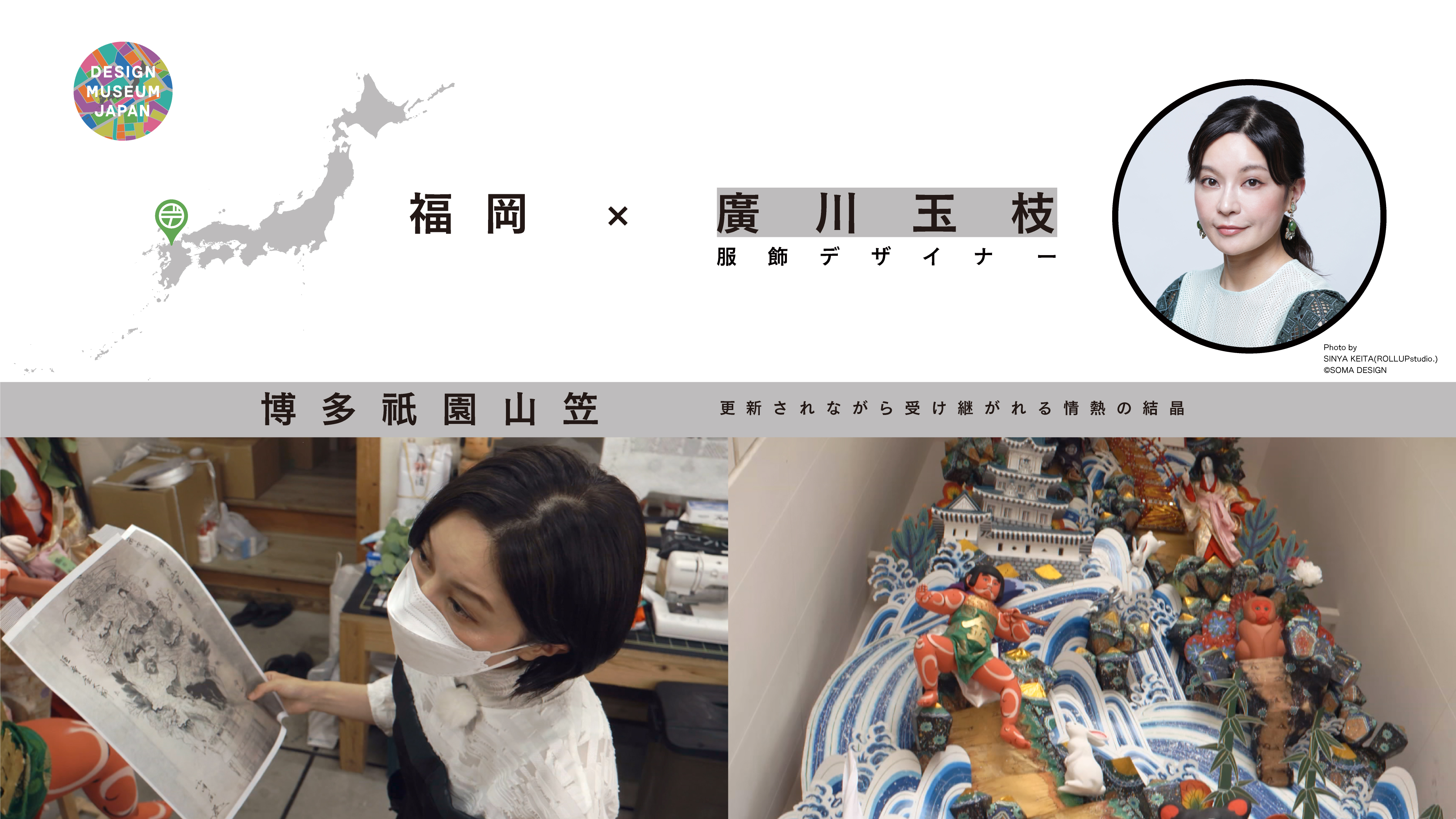Tamae Hirokawa researched “Hakata Gion Yamakasa Festival,” a festival that has continued for 700 years in Fukuoka. Hakata Gion Yamakasa is a rite of the Hakata district’s tutelary Kushida shrine. It has been suggested the festival had its roots in the Kamakura Period seven or eight centuries ago. In a time of pestilence in Hakata, the townspeople are said to have carried the priest Shoichi Kokushi, founder of the Jotenji temple, on a dais to calm the hungry spirits by sprinkling holy water through the streets. Yamakasa is the name of the portable shrines carried through the streets in this festival. Some used to be as much as 16 meters tall, but the installation of overhead wiring made that impractical and the old Yamakasa have since been replaced by the enormous but immobile Kazari Yamakasa and smaller Kaki Yamakasa floats, which are still paraded through town.
Tamae Hirokawa Fashion Designer
Hakata Gion Yamakasa Festival

DESIGN TREASURE
An Evolving Tradition that Embodies Passion and Excitement

The 2020 Kushida shrine Kazari Yamakasa (Rear)
CREATOR

Photo by SINYA KEITA(ROLLUPstudio.) ©︎SOMA DESIGN
Tamae Hirokawa Fashion Designer
After working for Issey Miyake, Hirokawa established Soma Design and commenced her SOMARTA design project. Seeking to extend the possibilities of how clothing is worn on the body, her Skin Series employed the technology of no-sew knits to produce the experience of donning a second skin. It attracted attentions after being worn by Lady Gaga and became the permanent collection of the New York Museum of Modern Art (MoMa) in 2017. In 2021, she collaborated with ASICS to produce podium jackets for the Tokyo 2020 Olympic and Paralympic Games.
Hakata Gion Yamakasa, embodying the passion and excitement of the people− design for pray
Kaki Yamakasa is the name for the portable floats. Their bearers race with them around town, so they must be far lower than the Kazari Yamakasa, but they still weigh as much as 1 ton even so and are borne by more than twenty people. No nails are used for the base structure. It is all held together by joints and hemp ropes. The biggest are well over 10 meters tall. The decorative themes cover a broad range from traditional symbols to contemporary cartoon characters. All are carefully crafted by the doll makers to delight the crowds anew each year. “They link people and connect the past, present, and future in a single line,” remarked Hirokawa.

Kaki Yamakasa in 2020
Courtesy of hakatagionyamakasa-shinkoukai

The 2020 Kushida shrine Kazari Yamakasa, Front side
Photo by Kazuo Matsumoto
Colors that energize spectators
“The Yamakasa Imparts Enormous Energy to the Atmosphere,” remarks Hirokawa. She looked at the dolls and components used for the brightly colored decorative mountains and said, “Red is the color of lifeblood. Gold is the color that dances in the light.” The Kazari Yamakasa is designed smaller on top and larger below according to principles of perspective. By altering the sizes of the figures and background according to their height above ground, the Kazari Yamakasa is made to appear even bigger than it really is. She wants as many children as possible, the leaders of the future, to experience the energy of the Hakata Gion Yamakasa. Hirokawa remarks that “The heart is moved by the designs of those who came before us. They provide seeds of inspiration and their craft spirit lives across the eras.”

Check the design drawing and the actual doll.


The bear and Kintaro painted effectively with a limited number of colors (The 2020 Kushida shrine Kazari Yamakasa, Rear side)
Festivals are created to convey memories of the past to the future−structural design
The diverse parts used for the background all used to be hand painted as a matter of course, but digital technology has also been added in recent years. “The qualities of the old drawings are incorporated with modern efficiency, and so the festival evolves,” Hirokawa remarks getting emotional. The new technology reduces the work load on the craft workers and continues the work of handing the Yamakasa on with adjustments suited to the age.
For example, a rock is digitally output and designed to be developed to 3-D specifications. Mass-produced parts can be used as is, or they can be colored or adjusted. The design also allows for flexible scaling and easy disassembly. Many of them allow for the reuse of parts in subsequent years.

The rock printed on paper

Finished product

Puppeteer Hiromine Nakamura explained a new approach to parts production.

Combining background components to create a sense of dynamism.
Where Can We See This Design Treasure?

Installation view: Fukuoka Prefecture, Hakata ward of Fukuoka City (Kyushu) by Tamae Hirokawa, DESIGN MUSEUM JAPAN Exhibition at The National Art Center, Tokyo, Japan, 2022
Hakata History Museum
1-41, Kamikawabata-machi, Hakata-ku, Fukuoka (Inside Kushida Shrine)
Click here for more details.
Kaigeido / Nakamura Ningyo Gallery
1-10-46 Sakurazaka, Chuo Ward, Fukuoka City, Fukuoka Prefecture 810-0024
Click here for more details.




























